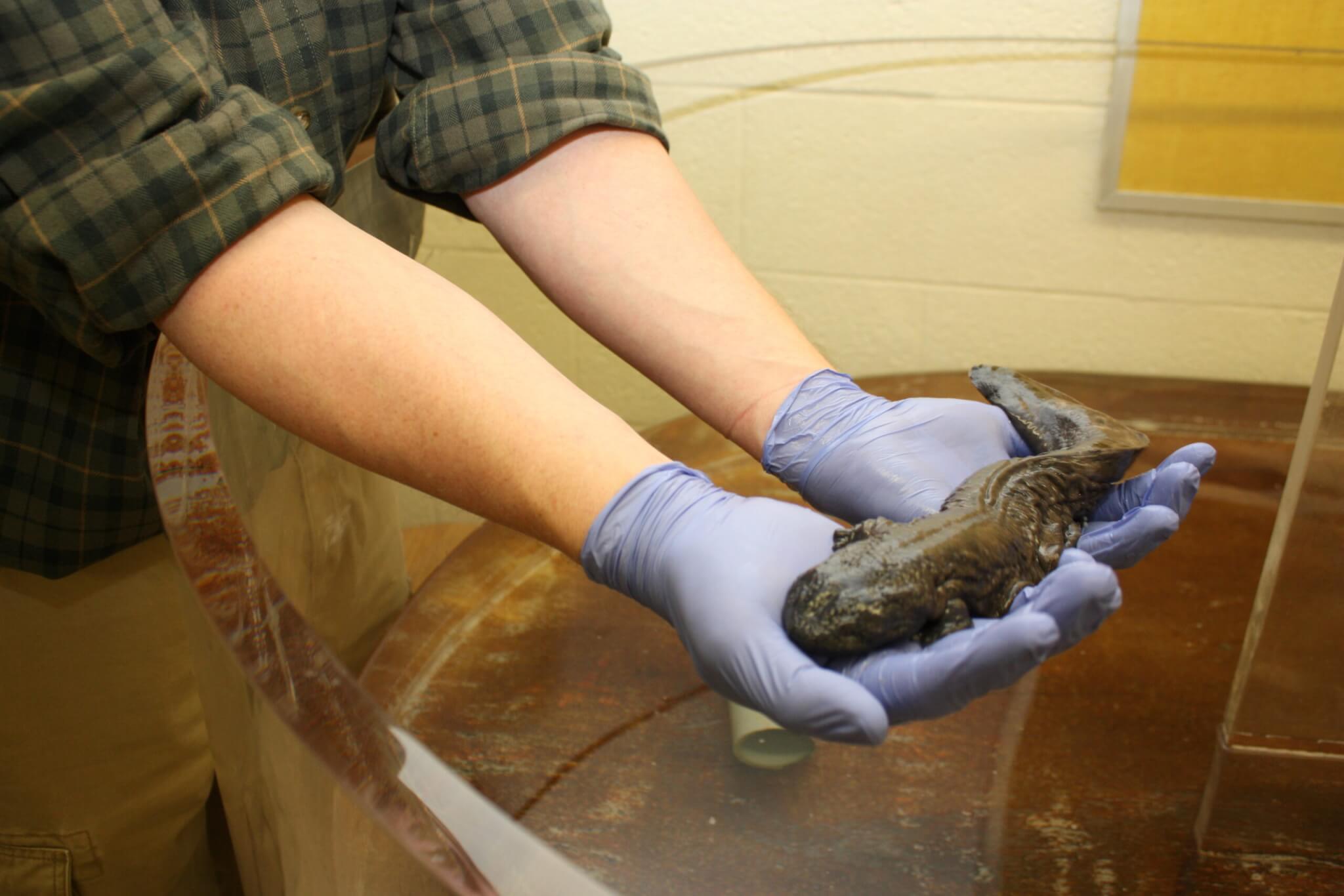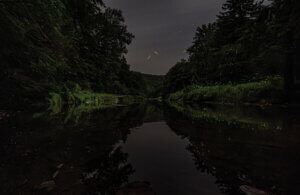

West Virginia biologist Joe Greathouse works to increase vulnerable salamander populations through new rearing techniques.
In the herpetology world, hellbenders are those celebrities you hear a lot about but don’t often see. Kieran O’Malley knew of them, sure. Working for nearly 20 years as a wildlife diversity biologist for the West Virginia Division of Natural Resources, he had developed an interest in reptiles and amphibians. For years, he’d set off from his Romney district office to search through streams and around riverbanks in West Virginia’s Eastern Panhandle, studying salamanders, frogs, and turtles.
He could tick off plenty of facts about the hellbender: It is the largest salamander in North America, its long slimy body can grow to be two feet long, and its folded skin is colored in brownish hues to help it blend in with the riverbed. But, unfortunately for O’Malley, the giant amphibian doesn’t live in West Virginia’s Eastern Panhandle, where he’s spent most of his career.

So when Joe Greathouse, assistant professor of biology at West Liberty University, asked O’Malley to go looking for hellbenders with him in the fall of 2015, he jumped at the chance. He joined Greathouse’s biology students as they carried nets and supplies down a large, healthy stream on the western side of the state that flows into the Ohio River. Once they reached the site, Greathouse, O’Malley, and several students waded into the water, looking for the kind of large, flat rocks hellbenders like to live under. The rocks were so big it took two or three people to lift them up as others stood by with nets at the ready.
Greathouse would wait for the water to clear a little before reaching down into the stream. The first time he pulled out a hellbender, O’Malley says he could feel the students buzzing around him. “Everybody was excited,” he says. Everybody, that is, except Greathouse. “Somebody’s got to keep their cool,” O’Malley says.
Holding the hellbender like a tiny alligator—with two fingers around a shoulder and his thumb on the opposite leg—Greathouse calmly put the hellbender in a net and took it to the side of the stream to begin measuring its length and weight. He instructed students as they ran some tests looking for amphibian chytrid fungus and a few diseases. They checked to see if the animal had been tagged with a tracking transmitter before placing it back into the river, under the rock where they found it.
O’Malley was thrilled. It was the first time he’d seen a hellbender in the flesh. And even better, he got to have that experience in the company of Greathouse. “He is the hellbender expert for West Virginia,” O’Malley says.
An Advocate for Amphibians
Greathouse’s reputation is well-earned. In 2004, Greathouse was working for The Good Zoo at Oglebay Resort in Wheeling when he began surveying the state’s hellbender population in partnership with the DNR. He discovered that, of the 33 streams where hellbenders were historically known to be found, only 12 of the streams still supported hellbender populations. “We know the species is declining throughout its entire range,” he says. “In West Virginia, we know populations have declined at least 40 percent over the past 30 years.”

As predators, hellbenders help to keep populations of animals like crayfish in check. Where hellbenders decline or disappear, an ecosystem’s balance is greatly altered. And as an indicator species, hellbenders serve as the canary in the coal mine when it comes to watershed quality. “They are probably some of the more sensitive amphibians,” O’Malley says. “When they start to disappear, something is wrong.”
To understand the causes of their decline, Greathouse started looking at water chemistry and the hellbender’s habitat. “When we see forest loss or lack of forest within a watershed, we don’t see hellbenders,” he says. Forest loss allows greater amounts of sand or silt to wash into waterways, which can cover small rocks that shelter hellbender larvae. And in extreme cases, large amounts of sedimentation can cover up large rocks where adult hellbenders live.
Greathouse and his team were also the first to discover that when the temperature rises to 72 or 73 degrees, hellbenders do not eat. “We think it’s just too hot for them. It probably shuts off some of their digestive enzymes,” he says.
As summer temperatures have risen in recent years, especially in the lowlands of West Virginia, hellbenders go three months in the summer without eating. The lack of food doesn’t kill them, but does make them lose weight, which can make them more vulnerable to predators like the river otter.
An Accidental Avocation
Greathouse, who is also now the director of The Good Zoo, was surveying a stream in 2007 when he came across a hellbender nest. He could see the nest had been infected by a fungus. If he left it alone, he knew all of the eggs would die. So he decided to take action.
After receiving the DNR’s permission to remove the eggs, Greathouse worked to separate the healthy eggs from the infected ones. Although he had no plans to begin rearing hellbenders, discovering that infected nest threw Greathouse into a new phase of his hellbender conservation efforts.
In 2007, The Good Zoo became the first zoo in the world to successfully rear hellbenders in human care. After raising his first nest of hellbenders for four years, Greathouse reintroduced the animals into a healthy West Virginia stream. He’s been working to rear and reintroduce hellbenders into the wild ever since.

“In a natural nest, hellbenders are going to have about 250 eggs. Only about one of those individuals is going to make it to adulthood,” Greathouse says. “When we raise them in a zoo, we have about a 90 percent success rate, so we can reintroduce realistically around 220 to 230 individuals and greatly enhance populations.”
He established rearing sites to raise the juvenile hellbenders at The Good Zoo, West Liberty University, and The Wilds, a private, nonprofit safari park and conservation center in Ohio where Greathouse worked from 2012 to 2016. He built artificial streams at West Liberty and The Wilds to hold larger hellbenders as they near adulthood. The streams are 15 feet long and lined with rocks and gravel. Water flows in one direction to create the feel of a stream.
After every reintroduction, Greathouse tracks the animal for at least one year. Because hellbenders are so difficult to find, Greathouse has also started using environmental DNA surveillance tools to look for hellbender DNA in a stream without having to comb every large rock—making stream surveys a little easier for researchers.
Since 2007, Greathouse and teams of students and researchers at West Liberty, The Wilds, and The Good Zoo have been able to rear between 1,100 and 1,200 hellbenders. Now zoos across the country are using the techniques Greathouse developed to rear their own hellbenders.
“We know that they do pretty well when we put them back into the wild,” he says. After reintroduction, the hellbender’s highest risk of death is predation from North American river otter and mink. They also die from severe storms, which can bury them in heavy rocks and gravel. To give hellbenders a better chance at survival, Greathouse is starting a training program to teach them to fear the scent of otter and mink.
It’s still too early to tell, however, if Greathouse’s work is actually helping to increase hellbender populations. It will be at least a decade before any determination can be made. “We’re hopeful, but we’re studying it,” he says.
Without Greathouse, O’Malley says, state and federal organizations wouldn’t have a clear understanding of the threats facing hellbenders. And without his work, they wouldn’t have a comprehensive look at where hellbenders are located throughout the state and where hellbender populations have the best chance of growing and thriving.
“He’s the one who’s telling us, who’s leading the charge,” O’Malley says. “It’s about stewardship.”
This story was originally published in the January 2017 issue of Wonderful West Virginia.
written by Anna Patrick













